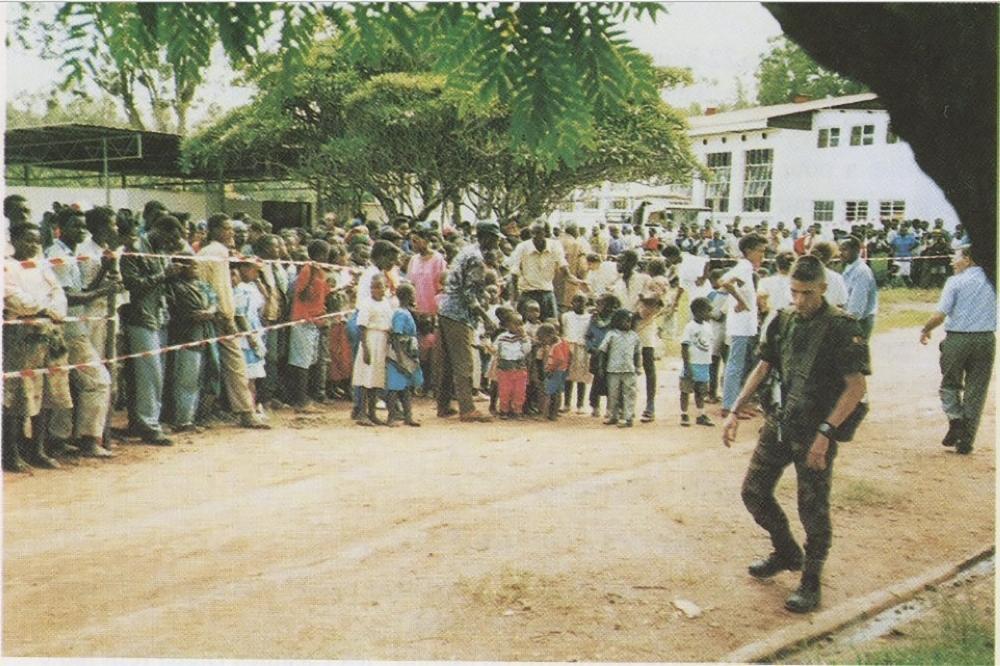Africa-Press – Rwanda. April 11, 1994, was marked by the withdrawal of Belgian forces from ETO Kicukiro (current IPRC Kigali), and the killers took advantage of the development to murder more than 2,000 Tutsi who had taken refuge at the facility.
At that time, the school was managed by the Salesian Fathers. Since 1963, many Tutsi had taken refuge at the school and survived the various pogroms that targeted them. Even this time around, they had hoped for safety, but it was not the case.
When the killings broke out, many Tutsi made their way to the school on April 8. While at the school, they endured an onslaught of gunshots and arrows, thrown their way by the killers from a distance. The attacks climaxed on April 11 when the genocidal forces, including Interahamwe militia, came into the facility and transferred them to Nyanza, Kicukiro where they were systematically massacred.
The disappointing withdrawal of the Belgian forces
In 1994, within the ETO compound, there was a post of UNAMIR troops who had come in the framework of peacekeeping. That is why the Tutsi had taken refuge there in large numbers, hoping to be protected by these well-armed UN soldiers.
Disappointingly, the UNAMIR soldiers withdrew from the place, leaving the refugees behind. What happened next was the massacre at Nyanza.
Leonidas Rusatira, a FAR soldier with the rank of Colonel brought in numerous soldiers who prevented the Tutsi from fleeing to the CND (current Rwandan Parliament) where the RPF soldiers were accommodated.
The FAR soldiers and Interahamwe then decided to transfer the Tutsi from ETO Kicukiro to Nyanza Kicukiro on foot. They went killing them on the way, from SONATUBES up to Nyanza. Those who had not died on the way were then exterminated at Nyanza by use of grenades, before Interahamwe came in to kill those who were still alive.
Massacres at the Church of Kiziguro Catholic Parish, Byumba Diocese
From 7 to 10 April 1994, the Tutsi coming from different localities began to take refuge at the Catholic Church of Kiziguro. They had been told that they were going to be protected there. However, this was just a trick to gather them in large numbers so that they would be killed.
On April 11, 1994, an attack was launched on the facility, killing the Tutsi who were hiding there. The massacres lasted from 10 am to 4 pm, carried out by the Interahamwe mobilised by former bourgmestre Jean Baptiste Gatete, Onesphore Rwabukombe mayor of Muvumba, as well as individuals including Jean de Dieu Mwange, and businessman Augustin Nkundabazungu.
The massacres were supervised by soldiers from Gabiro military camp sent by Major Nkundiye Leonard, a former commander of the presidential guard of Habyarimana.
The victims were massacred in the courtyard of the parish. Those who were killed were buried in pits near the primary school. Some of them were thrown into the pits alive.
Massacre of Tutsi at ADEPR Shagasha, Cyangugu
The Shagasha ADEPR was a church where many Christians went to pray, among them many Tutsi. When the Genocide started, many Tutsi went to hide there, mainly women and children, as men feared to be killed from there.
About 60 Tutsi women and children took refuge there from April 11, 1994. In this area, the Interahamwe put more focus on killing men. They would come to the facility and select male children and take them to be killed.
In order to prevent them from being killed, their mothers would cloth them in girls’ dresses.
In addition, male Tutsi who had been captured in sectors like Shagasha, Munyove and Rwahi were brought to ADEPR Shagasha to be massacred. Many Tutsi coming from these sectors were killed at this church.
More massacres took place in various parts of the country, including more than 15,000 Tutsi killed at Hanika Parish, Cyangugu prefecture.
For More News And Analysis About Rwanda Follow Africa-Press






